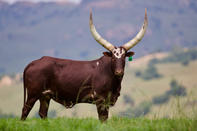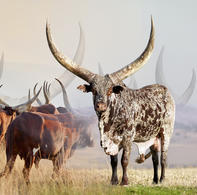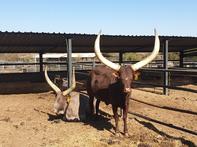Ankole cattle are part of the larger beef production industry of South Africa. This breed can be traced back to the hieroglyphs of the ancient Egyptians and has formed part of the longhorn cattle tribes for more than 6 000 years.

By migrating down the Nile River, the breed found their way to Uganda, known as the Pearl of Africa.
The Banyankole people in Western Uganda, after whom the Ankole was named, believe the breed was created by God and bought to them by the founders of the Ankole Kingdom. To them, the Ankole are “the Cattle of Kings”.
A myth also exists, as relayed by Elizabeth Katushabe, that cattle became extinct, but then reappeared following four days of rain after King Omugabe Nyabugarobwera Ntare shot at the sky with his bow and arrow, known as Enfumura Iguru. It is said that people’s homes were filled with cattle when they awoke on the fifth day. From then on, cattle grazed the beautiful land of Nkore.
Production in South Africa
The South African president, Cyril Ramphosa, made history when in 2004 he brought the first Ankole genetics into South Africa. He is said to have gained interest in the cattle after a visit to Ugandan President, Yoweri Museveni, but was unable to bring live animals into South Africa because of inadequate disease control measures in Uganda.
He then enlisted the help of Morné de la Rye, a vet and director of the embryo company, Embryo Plus. Ramaphosa then bought 43 cows, which were transferred from Uganda to an embryo station run by Embryo Plus in Kenya. Here the cows were artificially inseminated, and the embryos were flushed seven days later and sent to South Africa, where they were implanted into surrogate cows.
The Ankole Cattle Breeders Society of South Africa was formally established in February 2018 and boasted almost a thousand registered cattle by the middle of 2019.
Attributes

The cattle are renowned for their lean meat and excellent milk quality, making them a sought after dual breed. They have majestic ivory looking horns, which pointing to the African skies, come in various shapes and sizes. The horns are “honeycombed” and connected to airways, which helps these cattle to better regulate their body temperature.
They are able to adapt to harsh and extreme weather conditions from cold and rainy weather to hot, dry desert climates. They are able to thrive on low-quality forage and are highly disease and tick resistant, making them a robust and practical breed.
Various coat colours exist, including but not limited to roan to strawberry, dark to light brown and red. In the past, the unique coat colours, body types, behaviour and horn shapes were used as management tools to describe and identify each Ankole.
Production Regions
The breed, because of its ability to adapt to a wide range of climatic conditions, is able to thrive in most parts of South Africa.
Use

The breed may be used on its own, but has come under threat over the years due to its extensive use in crossbreeding programmes in Uganda. The cows produce lots of milk, which are sought after in Uganda and apparently tastier and healthier than milk from conventional dairy breeds.
Meat Quality
The meat is lean, tasty, low in cholesterol and high in Omega 3 and 9. The Ankole Cattle Breeders Society of South Africa claims that it will certainly draw the attention of health-conscious consumers and markets.
For bulk or Ankole Beef export enquiries please use the enquiry link below.